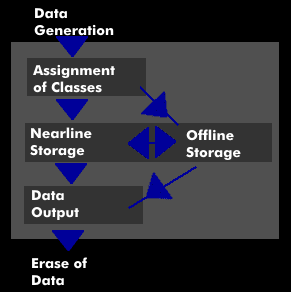information lifecycle management (ILM)
Information Lifecycle Management (ILM) is a broad, option-rich solution approach for the storage management of content and information. As with Hierarchical Storage Management( HSM), ILM does not treat the data stored in a storageareanetwork( SAN) indiscriminately, but assigns them values, classifications and attributes. The attributes can be used to set up sets of rules in the backup strategy. In general, the classification of data and its availability plays the decisive role in all ILM approaches.
When assigning stored data to its availability, the timeliness of the data at any point in time must be evaluated. Data that is current today loses its relevance for the business or production process over time and can therefore be evaluated and outsourced differently.
The ILM strategy assumes that all information has a specific lifecycle. ILM takes into account the entire lifecycle of information and considers data - which includes structured, semi-structured and unstructured data - in terms of their intrinsic value as records and documents that should be incorporated into business processes as effectively as possible, from creation through processing, distribution and long-term archiving to rapid retrieval. As with Hierarchical Storage Management (HSM), recoverability can be based on access frequency and intensity, but also on the age of the information or its integration into the business process. For example, by evaluating the data according to business aspects.
The areas of application of ILM include e-mail archiving, enterprise content management( ECM) or document management.

